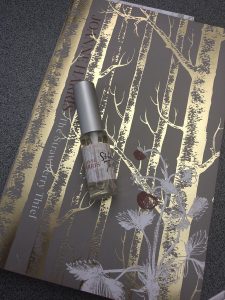I have a type of synaesthesia in which colours in bright light trigger scents. Perhaps that’s why I’m so drawn to light, and why I suffer from SAD in winter. It also affects the way I write: I often notice scents before I notice anything else, and that’s why my descriptions are so slanted towards scent and taste. Every one of my novels has had a particular scent – I use them to help me get into the zone, and to trigger the memories and feelings I so often need to access when I’m working on my books. I don’t usually share these scents – they’re simply part of my writing process – and yet I’ve often wondered if discussing this aspect of my work might be interesting – even rewarding – to my readers.
To me, reading should be as immersive an experience as possible, which means engaging all the senses; and for some time now I have been trying different approaches to storytelling – reading my own audiobooks; through music and songs with the #Storytime Band; linking fiction to recipes; working with illustrators – in the hope of finding new ways to bring the senses into the narrative.
But scent is elusive to convey. Its impact is primarily linked to memory and the emotions, which makes it very personal and difficult to articulate. And since those things are at the heart of my writing, and especially of this novel, I wanted to try and find a way of bringing some of that experience to my readers.
With that in mind, I asked CPL Aromas, the world leading fragrance company, to create a scent to accompany a passage from THE STRAWBERRY THIEF. I wanted the scent to be an illustration of the text in another medium; something that would help paint the scene using something other than pictures. And so I went to their labs in Bishop’s Stortford to see how the process worked – because scents have their own unique narrative, and, like stories, come from a place of imagination and creativity.
Their perfumers had created two fragrances for me; both of which were based on a chapter of my novel. Both were gourmand fragrances, though one was darkly autumnal – a petrichor combination of amber, chypre, cumin, bitter chocolate, cedar, sandalwood – and the other was a lighter, drier combination of many of the same ingredients, with a cheery bright note of vanilla and popcorn on the drydown. I loved them both, but I thought the lighter, brighter one might be more suitable for an April launch. To me it smelt of the changing winds; the turning of the seasons. And it was strange and unusual – and not entirely comfortable – and I loved the way it accompanied my narrative, telling a story of its own in its ephemeral medium.
I’m planning ways to use it now – maybe a series of scented bookmarks, and some scent samples to be sent out to potential reviewers. I may also use it alongside some of the readings I’ll be doing this spring, so that audiences can get an idea of how a scent can sometimes help to illustrate a story. The story doesn’t need a scent, just as no story really needs pictures: and yet, sometimes, illustrations – be they visual or otherwise – can sometimes connect us more closely than words alone.
The scent is called Xocolatl. And this is from the section of the book that inspired its creation:
“I walk into the kitchen. The scent of chocolate is strong, strong enough to silence her voice. The scent of other places rushes in to fill the void; the ozone of the Pacific; the salt tang of the Côte d’Emeraude. I put a handful of Criollo beans into the grinder. Their scent is very far from sweet. I can smell oud, and sandalwood, and the dark scents of cumin and ambergris. Seductive, yet faintly unsavoury, like a beautiful woman with unwashed hair. A moment in the grinder, and the beans are ready to use. Their volatile essence fills the air, freed from one form into another. The Maya tattooed their bodies, you know, in order to placate the wind. No, not the wind. The gods. The gods.
I add hot water to the beans and allow them to percolate. Unlike coffee beans, they release an oily kind of residue. Then I add nutmeg, cardamom and chilli to make the drink that the Aztecs called xocoatl – bitter water. That bitterness is what I need.”

